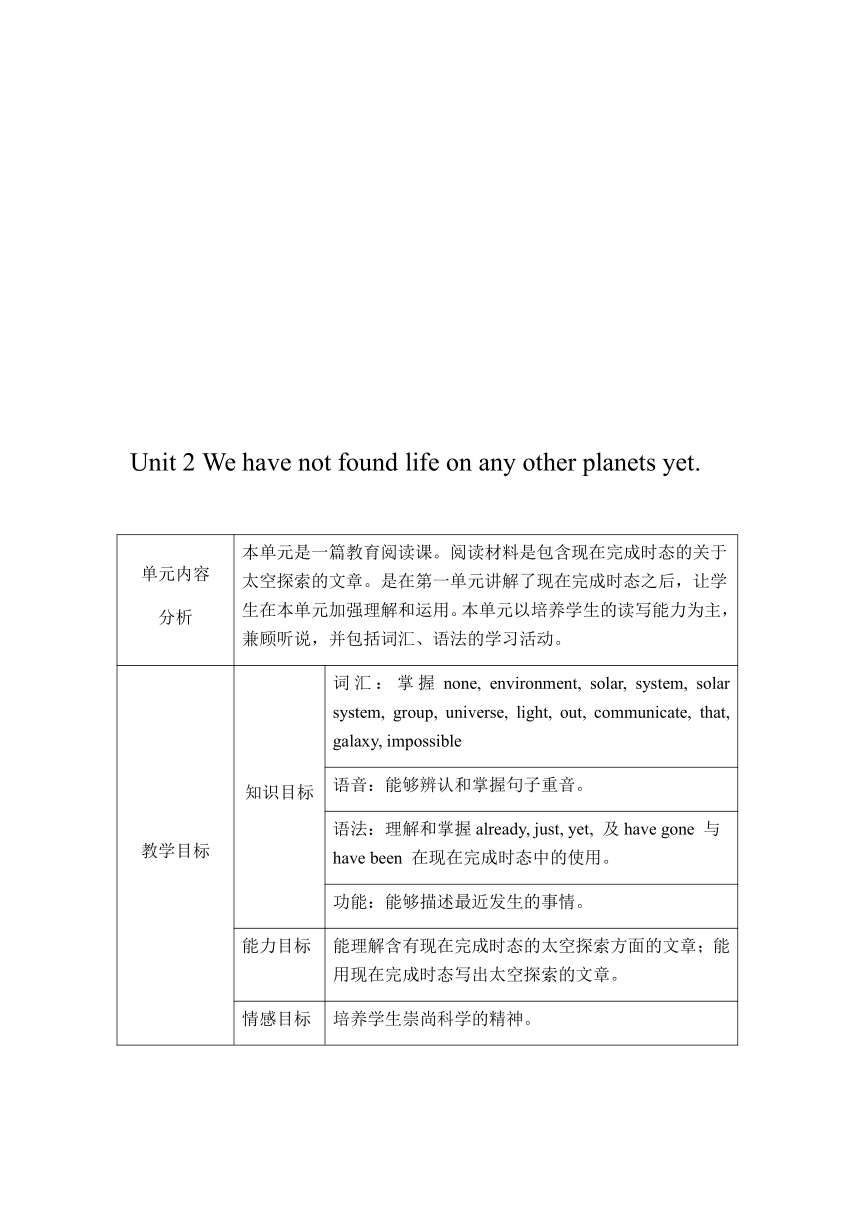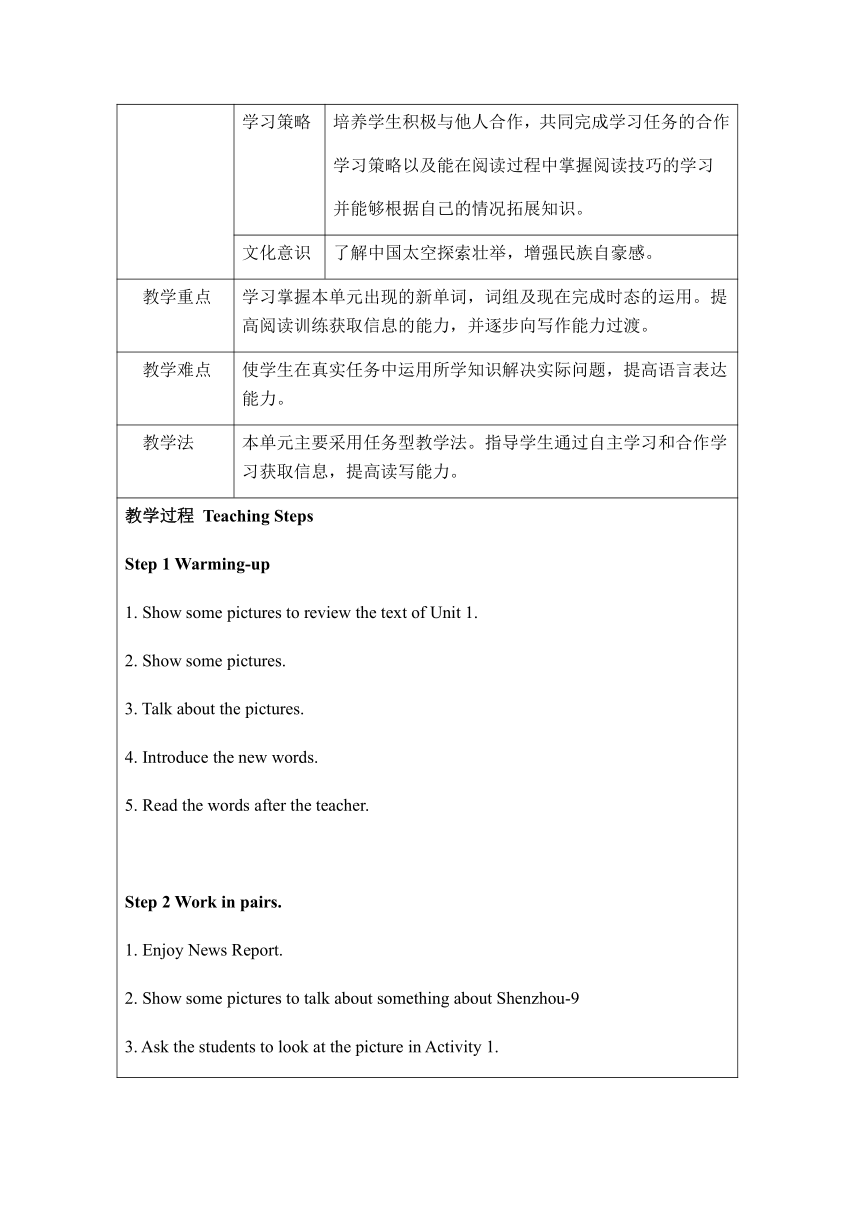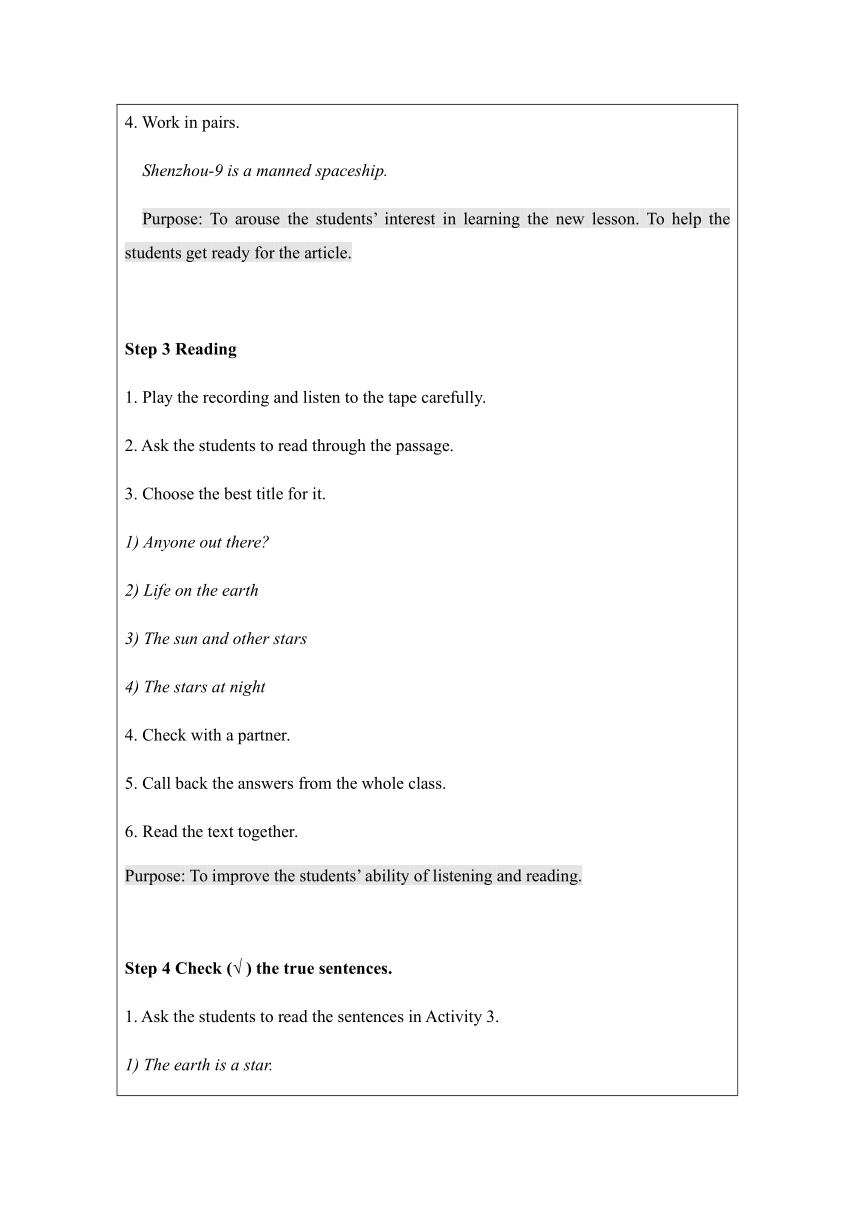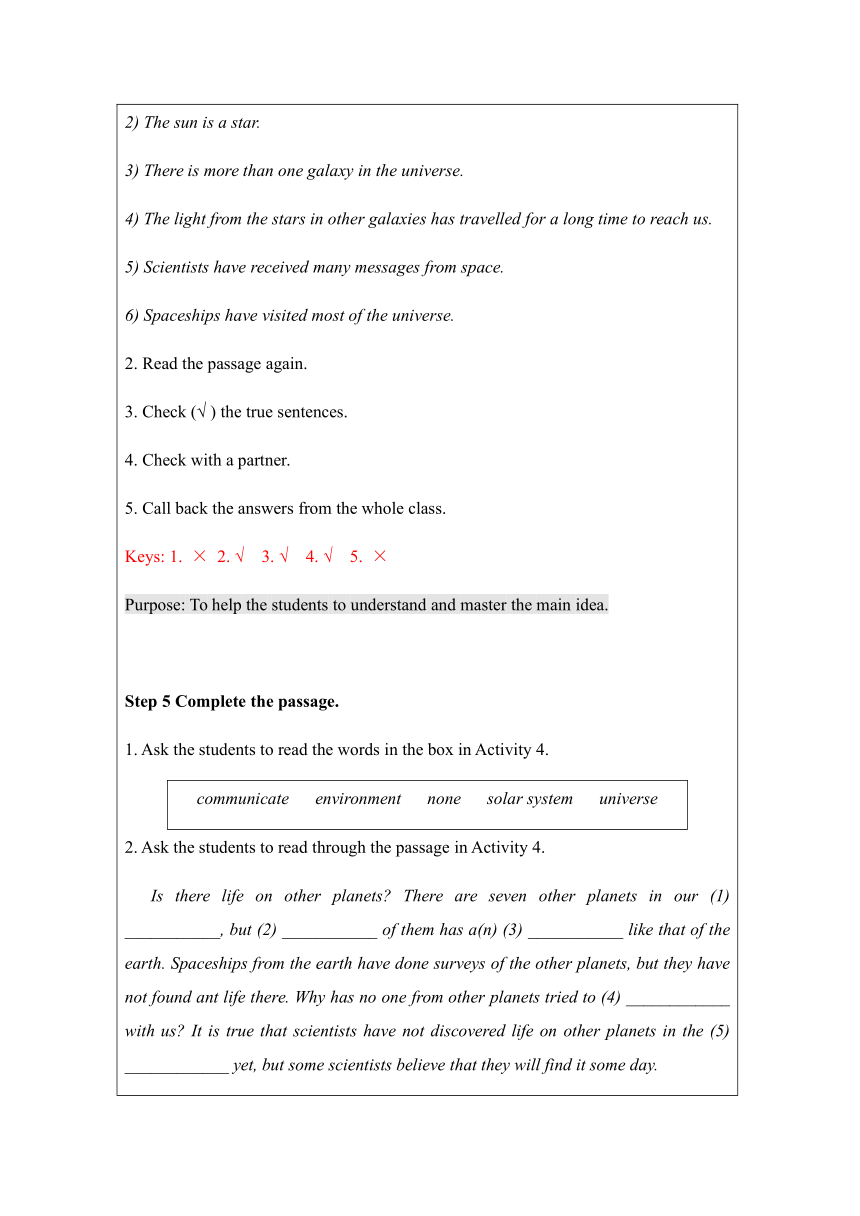外研版英语八年级下册:Module 3 Unit 2 We have not found life on any other planets yet. 教案
文档属性
| 名称 | 外研版英语八年级下册:Module 3 Unit 2 We have not found life on any other planets yet. 教案 |

|
|
| 格式 | zip | ||
| 文件大小 | 65.5KB | ||
| 资源类型 | 教案 | ||
| 版本资源 | 外研版 | ||
| 科目 | 英语 | ||
| 更新时间 | 2020-04-08 20:45:14 | ||
图片预览





文档简介
Module 3 Journey to space
模块内容整体分析
话题 本模块以太空之旅为话题,着重介绍了火星探索以及宇宙中太阳系的部分知识。要求同学们能够了解一些航天知识,用现在完成时描述人类已经实施的太空探索。
任务 能够收集有关太空探索的信息制作招贴画,介绍航天知识。
词汇 正确使用的单词和词组:Earth, news, yet, just, model, spaceship, project, latest, discover, astronaut, space shuttle, none, environment, solar, system, solar system, group, universe, light, out, communicate
语法 要求能够运用现在完成时描述人类已经实施的太空探索,正确使用already, just, yet, 能区分have gone 与have been 的用法。
语音 能够辨认和掌握句子重音。
学习策略 A、自学策略:能够根据自己的情况预习教材;能够根据自己的情况进行拓展和补救。B、合作学习策略:制作太空探索招贴画时能根据小组内同学的特长分工合作;
文化意识 了解中国“神州五号”、“神州六号”、“神州七号”太空探索壮举,增强民族自豪感。
重点难点 重点:学生听、说、读、写技能的培养(能够听懂有关太空探索内容的谈话,提取具体信息;能够介绍人类的太空探索经历;能够读懂有关太空话题的文章,掌握文章大意;能够写出有关太空探索的段落。)完成本模块的词汇及现在完成时的学习和运用。难点:使学生能有效地掌握信息,并在实际生活中运用所学知识。
Unit 2 We have not found life on any other planets yet.
单元内容分析 本单元是一篇教育阅读课。阅读材料是包含现在完成时态的关于太空探索的文章。是在第一单元讲解了现在完成时态之后,让学生在本单元加强理解和运用。本单元以培养学生的读写能力为主,兼顾听说,并包括词汇、语法的学习活动。
教学目标 知识目标 词汇:掌握none, environment, solar, system, solar system, group, universe, light, out, communicate, that, galaxy, impossible
语音:能够辨认和掌握句子重音。
语法:理解和掌握already, just, yet, 及have gone 与have been 在现在完成时态中的使用。
功能:能够描述最近发生的事情。
能力目标 能理解含有现在完成时态的太空探索方面的文章;能用现在完成时态写出太空探索的文章。
情感目标 培养学生崇尚科学的精神。
学习策略 培养学生积极与他人合作,共同完成学习任务的合作学习策略以及能在阅读过程中掌握阅读技巧的学习并能够根据自己的情况拓展知识。
文化意识 了解中国太空探索壮举,增强民族自豪感。
教学重点 学习掌握本单元出现的新单词,词组及现在完成时态的运用。提高阅读训练获取信息的能力,并逐步向写作能力过渡。
教学难点 使学生在真实任务中运用所学知识解决实际问题,提高语言表达能力。
教学法 本单元主要采用任务型教学法。指导学生通过自主学习和合作学习获取信息,提高读写能力。
教学过程 Teaching StepsStep 1 Warming-up1. Show some pictures to review the text of Unit 1.2. Show some pictures.3. Talk about the pictures.4. Introduce the new words.5. Read the words after the teacher.Step 2 Work in pairs. 1. Enjoy News Report.2. Show some pictures to talk about something about Shenzhou-93. Ask the students to look at the picture in Activity 1.4. Work in pairs. Shenzhou-9 is a manned spaceship.Purpose: To arouse the students’ interest in learning the new lesson. To help the students get ready for the article.Step 3 Reading1. Play the recording and listen to the tape carefully.2. Ask the students to read through the passage.3. Choose the best title for it.1) Anyone out there? 2) Life on the earth 3) The sun and other stars 4) The stars at night4. Check with a partner.5. Call back the answers from the whole class.6. Read the text together.Purpose: To improve the students’ ability of listening and reading.Step 4 Check (√ ) the true sentences.1. Ask the students to read the sentences in Activity 3.1) The earth is a star. 2) The sun is a star.3) There is more than one galaxy in the universe.4) The light from the stars in other galaxies has travelled for a long time to reach us.5) Scientists have received many messages from space.6) Spaceships have visited most of the universe.2. Read the passage again.3. Check (√ ) the true sentences.4. Check with a partner.5. Call back the answers from the whole class.Keys: 1. × 2. √ 3. √ 4. √ 5. ×Purpose: To help the students to understand and master the main idea. Step 5 Complete the passage.1. Ask the students to read the words in the box in Activity 4.communicate environment none solar system universe2. Ask the students to read through the passage in Activity 4.Is there life on other planets? There are seven other planets in our (1) ___________, but (2) ___________ of them has a(n) (3) ___________ like that of the earth. Spaceships from the earth have done surveys of the other planets, but they have not found ant life there. Why has no one from other planets tried to (4) ____________ with us? It is true that scientists have not discovered life on other planets in the (5) ____________ yet, but some scientists believe that they will find it some day.3. Complete the passage with the words and expression in the box.4. Check with a partner.5. Call back the answers from the whole class.Keys: 1. solar system 2. none 3. environment 4. communicate 5. universe6. Read the passage together.Purpose: To help the students to understand and master the main idea.Step 6 Language points1. Scientists think that there has been life on Earth for hundreds of millions of years. 科学家认为地球上的生命已经有亿万年了。millions of数百万,hundreds of 数百,thousands of 成千上万,billions of 数十亿e.g. There are billions of stars in the Galaxy, and our sun is only one of them.银河系中有数十亿颗恒星,我们的太阳只是其中的一个。2. The Earth is a planet and it goes around the Sun. Seven other planets also go around the sun. 地球是颗行星,它围绕着太阳转。还有其他七颗行星也围绕着太阳转。太阳系的其他七颗行星:水星(Mercury)、金星(Venus)、火星(Mars)、木星(Jupiter)、土星(Saturn)、天王星(Uranus)、海王星(Neptune)。3. None of them has an environment like that of the earth, so scientists do not think they will find life on them.他们中没有一个有像地球这样的环境,因此科学家认为在他们上面找不到生命。none pron. 没有一人;没有一个;一点儿也没none of … 表示(三个以上)一个也没有。做主语时,谓语动词可用单数或复数。e.g. None of us _______ interested in the story. 我们中没有人对这个故事感兴趣。 None of us ________ been to the Mars. 我们中没一个去过火星。4. … our solar system is a small part of a much larger group of stars and planets, called the Galaxy or the Milky Way.我们的太阳系只是一个由恒星和行星组成的星系的一小部分,这个星系比太阳系大得多,称作银河系或银河。这里的the Galaxy专指“银河系”,也可以称作 the Milky Way。而galaxy则泛指“星系”。例如:Scientists have discovered a distant galaxy. 科学家们发现了一个遥远的星系。5. So how large is the universe? It’s impossible to imagine.所以宇宙有多大?我们无从想象。句型: It is +形容词 + to +动词原形,意思是“做某事很……”It is difficult to read these words. 读这些单词很难。6. With so many stars in the universe, are we alone, or is there life out there in space? 宇宙中有这么多恒星,我们是孤独的吗?抑或太空中还有其他生命存在呢?with + 名词 + 介词短语,表示伴随情况,意思是“带着……”。 例如:Mr. Zhang is coming with a book in his hands.张老师手里带着一书进来了。alone 在句中作形容词,不作定语只做表语,也可作副词。意思是“独自地”。例如:She was alone in that dark room. 她独自一人呆在那黑屋子里。7. Why has no one communicated with us?为什么没人和我们联系?no one意为“没有人”,多用来指人。当它用作主语时,谓语动词要用单数形式。 e.g. No one came here yesterday. 昨天没人来这。 none可用来回答how many或how much的提问,no one可用来回答who的提问e.g. —How many birds can you see in the picture? —_______. —Who is in the room? —________.请从括号内选择适当的一项填空,使句意完整通顺。1) —How many cakes are there in the fridge? —??_________ (None / No one).2)?__________ (None / No one) writes to me but you.communicate既可作及物动词,又可作不及物动词。作及物动词时,意为“表达,传达”;作不及物动词时,意为“沟通,交流”,常与介词with连用。e.g. I asked your sister to communicate my wishes to you. I shall communicate with you directly.根据汉语意思完成英语句子。1) 玛丽(Mary)经常与她的老师们交流。 Mary often _________________ her teachers.2) 在他的帮助下,我们试着向父母表达了我们的感情。 With his help, we tried to _______________ our feelings to our parents.Purpose: To help the students to master the language points and the grammar: the present perfect tense.Step 7 Look and answer the questions.1. Look at the picture from a science story for children in Activity 5. 2. Read through the example sentencesWhat have the scientists just received? (a message from one of our spaceships)They have just received a message from one of our spaceships.3. Ask the students to answer the questions.1) Where has the spaceship landed? (Mars)2) What has the spaceship discovered? (people on Mars)3) Why have the people on Mars not sent us a message? (do not know how to)4) Why have the people on Mars not visited us on the earth? (do not know how to)4. Check with a partner.5. Call back the answers from the whole class.Keys:1. It has landed on Mars.2. It has discovered people on Mars.3. They do not know how to send us a message.4. They do not know how to visit us on the earth.Purpose: To get the information ready for the writing.Step 8 Writing.Write a passage to describe the picture. Use your answers to the questions in Activity 5 to help you.We have just received a message from our spaceship to Mars…Purpose: To improve the students’ ability of writingStep 9 Do exercises:下列各题划线部分中均有一处错误,请指出并改正。1. No one of his friends has been to Paris. __________________2. I haven’t found my new basketball already. _______________3. There are million of people in the stadium. ______________________Keys:1. No one → None??2. already → yet??? 3. million of → millions of Step 10 Homework:Read and retell the story. Finish the Activity 6 on page 21. Do WB P20-22
板书设计 Unit 2
教学反思 因为本文是科技性文章,对于学生来说不是很容易理解,所以要重视课前相关知识的搜集以辅助学生课上的学习。教师应尽可能多地创设情境帮助学生运用所学的语言知识;学生也应充分利用现有的有效资源来学习英语。
同课章节目录
- Module 1 Feelings and impressions
- Unit 1 It smells delicious.
- Unit 2 I feel nervous when I speak Chinese .
- Unit 3 Language in use
- Module 2 Experiences
- Unit 1 I've also entered lots of speaking competi
- Unit 2 They have seen the Pyramids.
- Unit 3 Language in use
- Module 3 Journey to space
- Unit 1 Has it arrived yet?
- Unit 2 We have not found life on any other planet
- Unit 3 Language in use
- Module 4 Seeing the docto
- Unit 1 I haven't done much exercise since I got m
- Unit 2 We have played football for a year now
- Unit 3 Language in use
- Module 5 Cartoons
- Unit 1 It's time to watch a cartoon.
- Unit 2 Tintin has been popular for over eighty yea
- Unit 3 Language in use
- Revision module A
- Module 6 Hobbies
- Unit 1 Do you collect anything ?
- Unit 2 Hobbies can make you grow as a person.
- Unit 3 Language in use
- Module 7 Summer in Los Angeles
- Unit 1 Please write to me and send me some photos
- Unit 2 Fill out a form and come to learn English
- Unit 3 Language in use
- Module 8 Time off
- Unit 1 I can hardly believe we are in the city ce
- Unit 2 We thought somebody was moving about
- Unit 3 Language in use
- Module 9 Friendship
- Unit 1 Could I ask if you've mentioned this to he
- Unit 2 I believe that the world is what you think
- Unit 3 Language in use
- Module 10 On the radio
- Unit 1 I hope that you can join us one day
- Unit 2 It seemed that they were speaking to me in
- Unit 3 Language in use
- Revision module B
